Abandoned carts have become a headache? Learn different tactics that you can start applying in your Shopify store to reduce the number of visitors that leave your ecommerce without completing the purchase process.
In the middle of 2021, abandoned carts continue to be one of the main headaches for those who have an online store.
It is a very common problem that surely you have encountered quite often.
According to data from the Baymard Institute , which has been obtained by collecting data from 41 other studies, almost 70% of carts are abandoned.
What does this mean?
That 7 out of 10 people who add a product to the cart in your store leave without completing the purchase.
Many ecommerce store owners do not pay much attention to this data, thinking that these customers cannot be recovered, but nothing is further from the truth.
In this article, I'm going to show you different tactics that you can apply in your Shopify store to reduce the number of users who leave your store without completing the purchase process.
But for this, the first thing is to know what the shopping cart abandonment rate is, so let's start with it.
What is the shopping cart abandonment rate?
A customer visits your Shopify store with the intent to buy.
You start to add products to the cart, but…
Suddenly, for some reason, it leaves the items that it had added abandoned in the cart.
This is what is known as an abandoned cart.
But what is the shopping cart abandonment rate?
The cart abandonment rate is the percentage of shoppers who have added items to their cart but ultimately left the store without completing the cart.
This rate is a very important metric that every online store owner should take into account, as it is directly related to both conversion rate and revenue.
A high abandoned shopping cart rate is an indication that your checkout process or shopping experience needs to be reviewed.
Reasons why users abandon their shopping carts
Surely you have wondered why your users add something to the shopping cart but leave without completing it.
According to a study by IAB Spain, 78% of Spanish shoppers have ever added something to the shopping cart but left the store halfway.
But, what are the main reasons why a user abandons products in the shopping cart?
1. Unexpected additional costs
Extra costs like shipping, taxes, or other additional fees are one of the main reasons for cart abandonment.
Customers want to know what they are going to have to pay before starting the purchase so they are not surprised when they are in the payment process.
2. Obligation to create an account to make the payment
I know that it is important for any online store to get customer emails to later carry out marketing campaigns, but that does not matter to them.
Increasingly, many users want to be able to make a purchase without the need to create an account.
For this reason, it is important to offer the possibility of making a purchase as a guest in your Shopify ecommerce.
3. Long and complicated purchase processes
How long is the form that the customer has to fill out in order to make the purchase? Do you ask them for unnecessary data?
Online purchases have to be as fast and efficient as possible, so the longer and more steps the purchase process has, the more customers you will lose.
4. Little offer of payment methods
How many payment options do you offer your customers in your online store?
Customers have their preferences when it comes to paying, which is why it is important to offer variety so that they can freely choose which one to opt for.
If you only offer one payment method in your store, many customers will leave without finally making the purchase.
5. Delivery times longer than expected
Buyers expect to receive their products as soon as possible, if they are going to have to wait longer than necessary, they will go to another store to buy it.
In addition, not knowing the estimated delivery date until they are in the checkout process is also a big mistake, which causes many customers to leave the store without finalizing the purchase.
According to the same study that we have mentioned before, the study carried out by IAB Spain , the main reasons why Spanish users abandoned their carts in 2020 without finally making the purchase were various.
The top 3 reasons were that they left it with the intention of thinking better of it, that there were hidden costs that they discovered at checkout or that the prices were confusing and unclear.
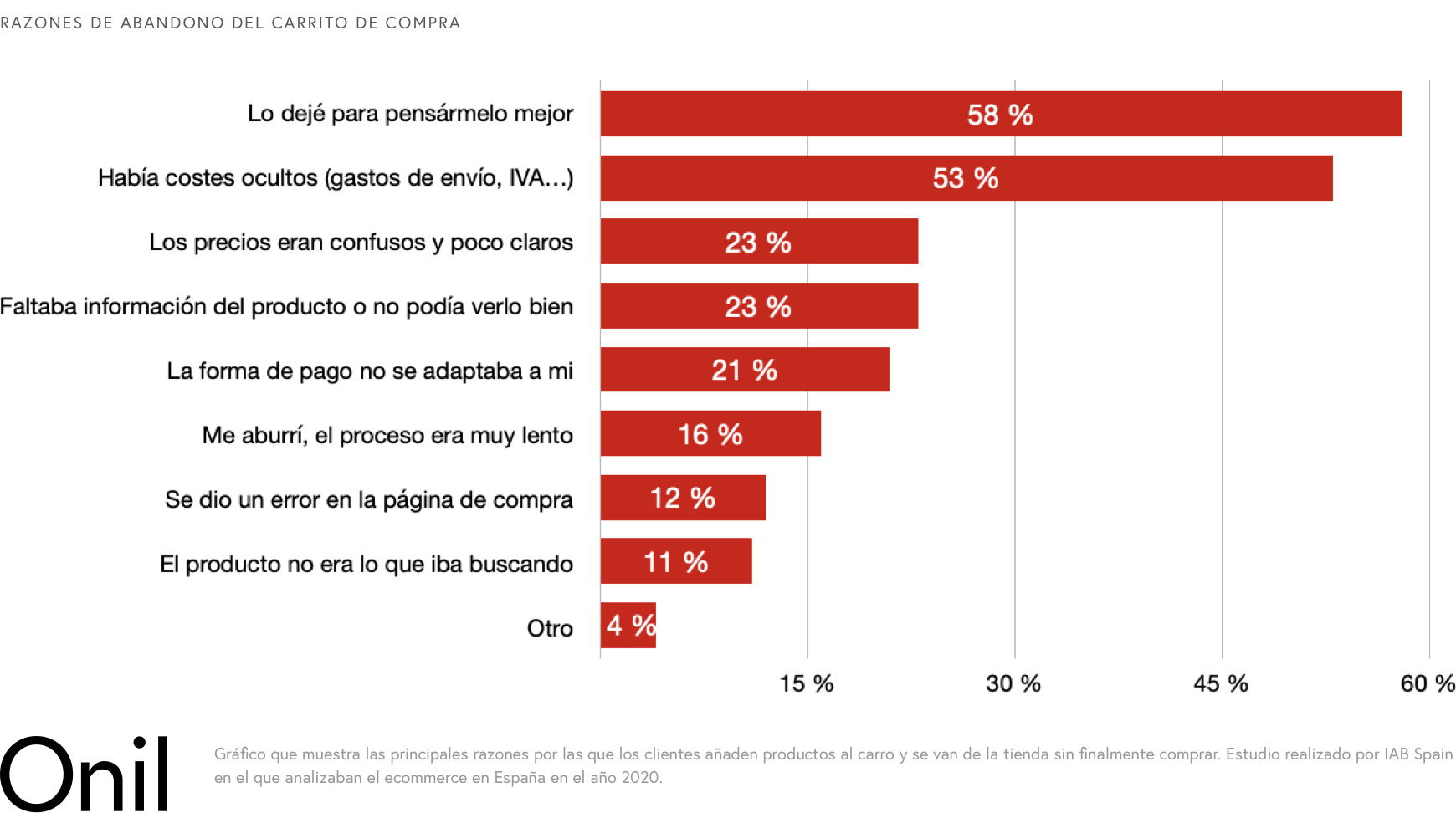
How do I calculate the cart abandonment rate for my Shopify store?
As I have already told you, the abandoned cart rate represents the percentage of customers who have not completed the purchase process.
But how can we calculate this key performance indicator?
You will need the following data:
- Total number of purchases completed in the time period you want to analyze.
- Number of shopping carts created in the same period of time.
I'm going to show you an example of how to calculate this rate with numbers.
Imagine that in the month of July the total number of completed purchases has been 2,500 and the number of shopping carts created in that same month has been 4,500.
So, what would be the abandoned cart rate of your online store?
It is as simple as applying the following formula:
Formula to calculate the "Abandoned cart rate":
1 - (Total number of completed purchases / Number of shopping carts created) x 100
In the case we are looking at:
1 - (2,500 / 4,500) x 100 = 44.44%
So the abandoned cart rate of your online store would be 44.44%.
Abandoned cart rate in your Shopify store
In order to know what the cart abandonment rate of your Shopify store is, you have to enter the administration panel of your Shopify store and access the "Analytics" section and within "Analytics", go to the General Information panel.
Once inside that panel, you have to look for the data of the Conversion Rate of your store that is broken down into 3 parts: Added to the cart, Payment reached and Sessions converted.
But, before that, it is convenient to choose the period of time in which you want to analyze your Cart Abandonment Rate, so that it shows you the data that interests you.
In this case, I am going to take the data from byta , a brand of cans in which to carry your favorite drink or food with minimal environmental impact, with which we have been working since its inception.
I select the period of time that interests me, in this example I have taken the last 90 days.
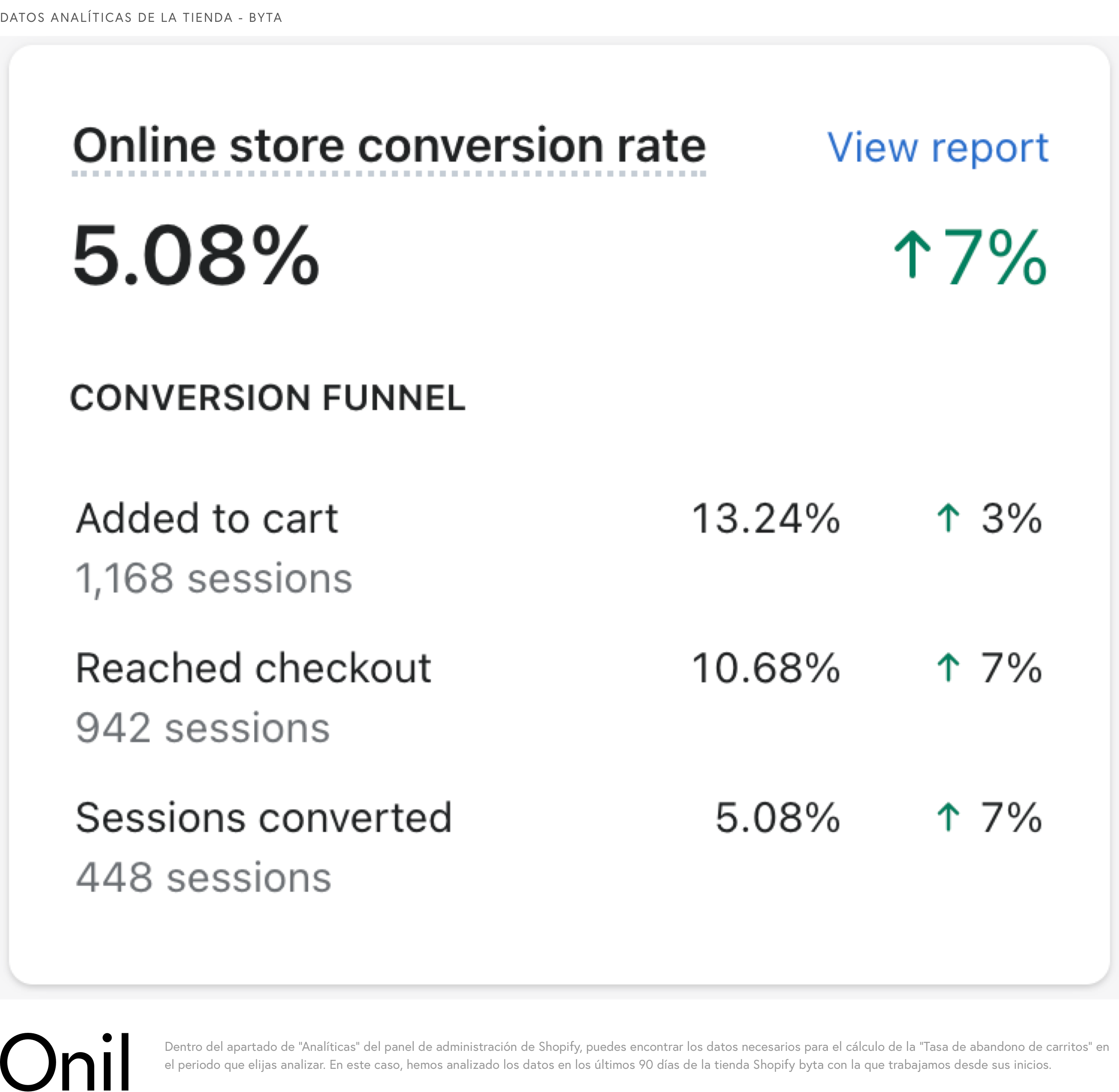
Once that is done, you just have to substitute the data in the formula:
*1 - (448 / 1168) x 100 = 61.64%
The cart abandonment rate of the byta store in the analyzed period would be 61.64%.
6 amazing ways to recover sales
1. Use social proof
How many times have you bought a product because a friend recommended it to you?
Surely many!
The same thing happens in an ecommerce.
Very often we look at the opinions of other people before placing an order for a product that we do not know, in order to finish convincing ourselves to make the purchase.
For that reason, it is so important to add what is known as "Social Proof" or "Social Proof" in our store.
Adding different social proofs in your ecommerce not only helps you generate more sales and reduce the Abandoned Cart Rate, but also to build trust.
The more customers you show are using and enjoying your product, the more likely you are to convince new customers to buy from you.
What are the most common ways to display “Social Proofs” in an online store?
- Show badges that build trust
- Show customer testimonials
- Show posts from other social media users
- Show actual sales notifications
- Display “What they say about us or trust us…” logos
Show badges that build trust
Trusted logos affect the purchasing decisions of most customers.
But, what distinctive can we use in our online store for this purpose?
There are 3 types:
- SSL certificate badges : This is to show that your store is secure. In the case of Shopify, it provides this SSL certificate to all stores by default.
- Badges of payment methods : You can include the logos of the different payment methods that your store accepts such as credit cards, Paypal... It is a useful way to build trust since they are companies that customers already trust.

- Security Seals : You can include security seals indicating that your store meets industry security requirements. Security seals like Norton or Mcafee can help you generate that security.

Show customer testimonials
Customer testimonials are one of the most important social proofs.
On the checkout page, where the customer is about to finalize their purchase, the opinions of other buyers are especially important, since it is a way of persuading the customer to finish the purchase by knowing first-hand what others think of your products and your store.

In order to display customer testimonials on the checkout page of your Shopify store, I recommend using Yotpo or Stamped .
Either of the 2 would help you to add that functionality to your Shopify store.
Show posts from other social media users
It is very common in ecommerce to use customer posts on social networks as social proof.
Because?
Well, because the more followers the brand has, the more users will trust it.
A good method is to show the publications in the RRSS of your clients using the products that they have previously bought in your online store.
In this way, users who are doubting whether to complete their purchase or not, when seeing the publications of real customers using the product, will feel more secure to make the purchase.
A good example is the one carried out by Morphe , a makeup brand with more than 10 million followers on Instagram, whose product page contains images uploaded by other users who have purchased the same product.

In addition, you also give the customer the option that once they have purchased from you, they become part of your brand's fan club, being able to upload their own photograph with the product in use directly from the page with a button like in Morphe - "Add your photo”.
In the case of Morphe, the application he is using in his Shopify store is Pixlee , which allows him to integrate the content of both influencers and customers of his ecommerce.
You can also use this other application in your Shopify ecommerce: Instafeed .
Instafeed also allows you to use content created by your users to display on your online store, in a similar way to Morphe.
Show actual sales notifications
Surely you have seen it in other ecommerce.
It is nothing more than showing users who are currently browsing your online store or have added products to the cart, notifications in which they can see that other customers have just made a purchase in your e-commerce.
This tactic is very useful as it encourages the user to act in the same way as the customer who just bought, motivating the customer to complete the purchase.

In the case of 12th Tribe, they have the Fomo app installed in their Shopify store, which helps build trust, credibility, and sales thanks to social proof of real sales.
Display “What they say about us or trust us…” logos
Another useful form of social proof that you can use on the cart page to motivate the customer to checkout is to display a series of “used by or seen us on…” logos.
It is advisable to use names of clients or companies recognized by the client so that in this way they think…
"If that recognized client or company buys or talks about this online store, it will be for a reason"
And give him the push he needs to finally buy in your ecommerce.

2. Use exit-intent pop-ups to prevent customers from leaving
Another way to reduce shopping cart abandonment is to create pop-ups that use Exit-Intent technology.
You will ask yourself…
What kind of pop-ups are these?
Exit-intent popups are those that are triggered when the visitor is about to click the exit button.
That is, the technology known as Exit Intent tracks the mouse movements of website visitors and detects when a user is about to leave your online store without completing the purchase.
And it is just at that moment when this pop-up appears, capturing the user's attention at the moment when they are thinking of leaving your e-commerce.
You can take advantage of this type of pop-up windows to encourage the customer to continue in your store with a coupon or discount for their purchase.
So, is the exit-intent popup that important to a Shopify store?
Of course!
They are an excellent opportunity to encourage customers to stay in your online store.
See how Chubbies , a fun men's clothing brand, uses this type of pop-up when a customer who has an item in their cart intends to leave without buying.

In the case of Chubbies, in order to use those exit-intent popups, they use Shopify Nosto in their store.
Although there are also other applications that you can install in your Shopify ecommerce such as Personizely or Optimonk .
No matter which one you install, all 3 can help you encourage the customer to finish the purchase and thus prevent them from leaving the store without buying.
3. Eliminate unexpected additional costs
Nobody likes unpleasant surprises.
And unexpected additional costs are a very unpleasant surprise.
In fact, they are one of the main reasons why customers abandon their shopping carts and leave the store without actually buying.
If you offer free shipping from €50 in your online store, but you don't mention it anywhere on the page, a customer who wants to buy a product for €30 will be surprised when they see an increase of €30 when accessing the checkout because of shipping.
Therefore, it is very important to have a notice bar in which the information related to this type of costs such as shipping appears, so that the client is informed at all times and does not find out when the purchase is about to end. buys.
With Shopify, informing your store visitors of these types of costs such as shipping is very simple.
In the templates that Shopify offers, you can find these announcement bars or "Announcement Bar", which are used to keep the customer informed from the beginning of both additional costs and promotions or new launches.
See how Groomfy - a client we work with - uses that banner bar to inform visitors about unexpected costs like shipping.
“FREE SHIPPING ON ALL SUBSCRIPTIONS!”

4. Offer the possibility to users to buy as a guest
Never force your users to create an account in your store in order to make a purchase.
Give them the opportunity to carry out the purchase process as a guest, that is, without having to register.
According to data collected by Invesp , not offering customers the ability to checkout as a guest is one of the leading causes of cart abandonment.
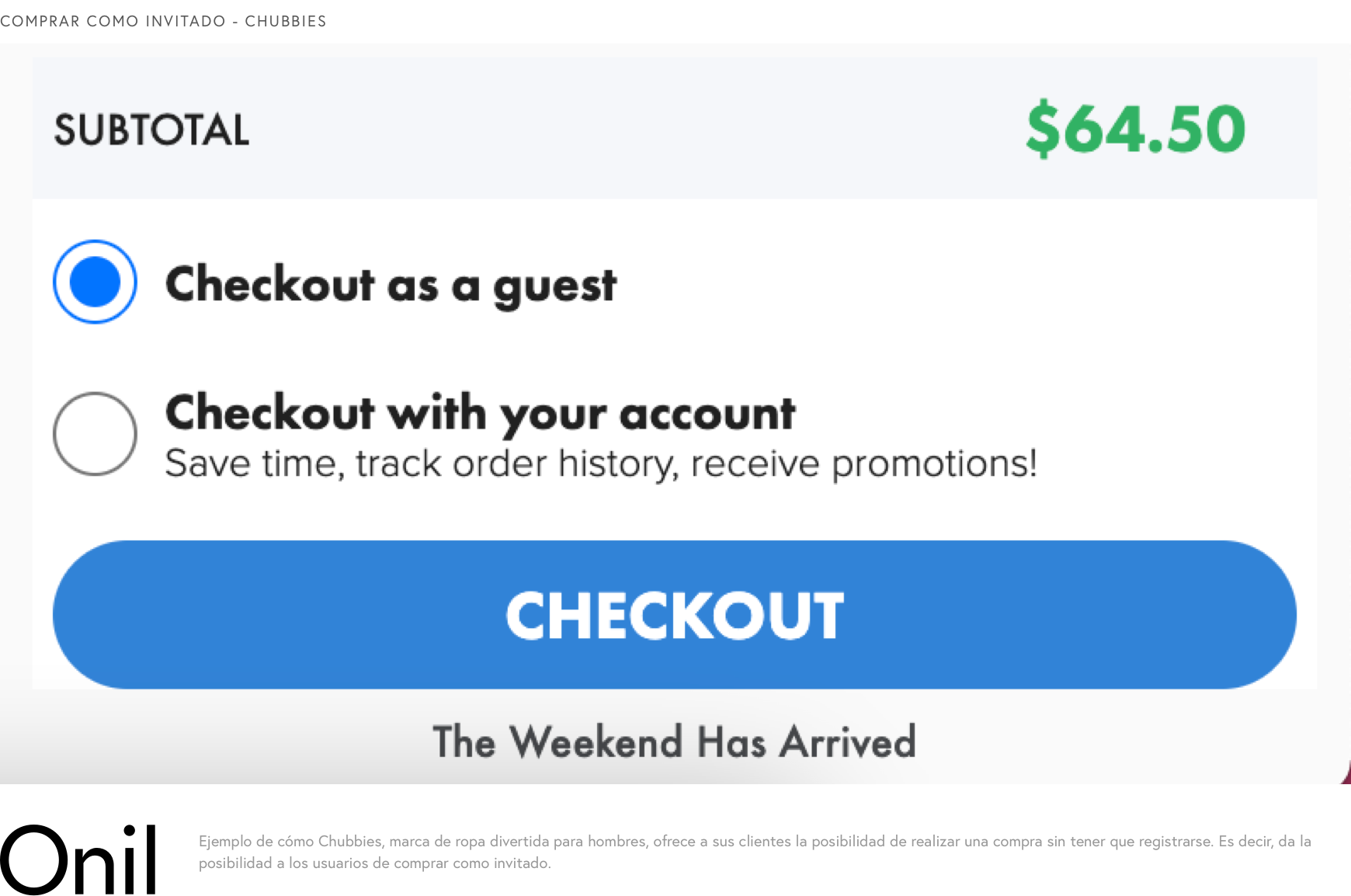
Approximately 14% of online shoppers indicated that forcing them to log in or create an account in order to complete a purchase was more than enough reason to leave the page without purchasing.
5. Offer your customers different forms of payment
Why simply offer Paypal in your Shopify store as an alternative to the traditional payment method?
Don't just stay there and explore many other options.
When you limit checkout to just one option, you are inadvertently increasing the chances that your customers will abandon their cart without purchasing.
And although Paypal is still a popular payment method for customers, mobile payment systems such as Apple Pay or Google Pay are also becoming very popular, especially among younger people.
Some of the most popular payment methods are:
- Shopping applications such as Shop Pay or Paypal
- Digital wallets like Apple Pay, Samsung Pay and Google Play
- Buy now, pay later like Klarna, Aplazame or Clear Pay
Do not hesitate and offer a wide variety of payment methods in your store, since in this way you will minimize or eliminate one of the reasons why customers abandon just at the moment of making the payment.

6. Send Cart Recovery Emails
As I have told you throughout this article, cart abandonment in the middle of 2021 continues to be one of the most important problems in ecommerce.
Many Shopify store owners do nothing to try and fix this problem, but others send potential customers abandoned cart recovery messages, encouraging them to come back to the store and complete their purchase.
First of all, it is to understand what abandoned cart emails are.
Well, they are those emails that are sent to customers who have added products to the cart but have left without making the purchase.
As a noteworthy fact, a recent report by Klaviyo says that companies that send cart recovery emails recover between 3 and 14% of lost sales.
These types of emails are used to remind potential buyers of the products they have left behind and encourage them to return to the store to buy them.
As?
Personalizing the emails you send with discount codes, forgotten product images, CTA buttons and much more, with the sole purpose of making them return to your store.
Cart Recovery Email Best Practices
1. Highlight the product that has been left forgotten in the cart
It sounds obvious that in the email you send to the customer reminding them that a product has been forgotten in the cart, the abandoned product must appear in the cart, right?
It is advisable to include the product with a prominent image of it, a text that encourages them to return to the store to buy and a simple and visual button that takes the customer directly to the checkout page, all ready to make the purchase.
A good example is the one carried out by Allbirds, a brand of shoes inspired by natural materials.
If you add a product to the cart and leave the store just at the last moment before making the payment, some time later they send you an email letting you know that you have a product in the cart waiting for you.
As you can see in the following screenshot, Allbirds shows you which product you have left behind with an image of it.
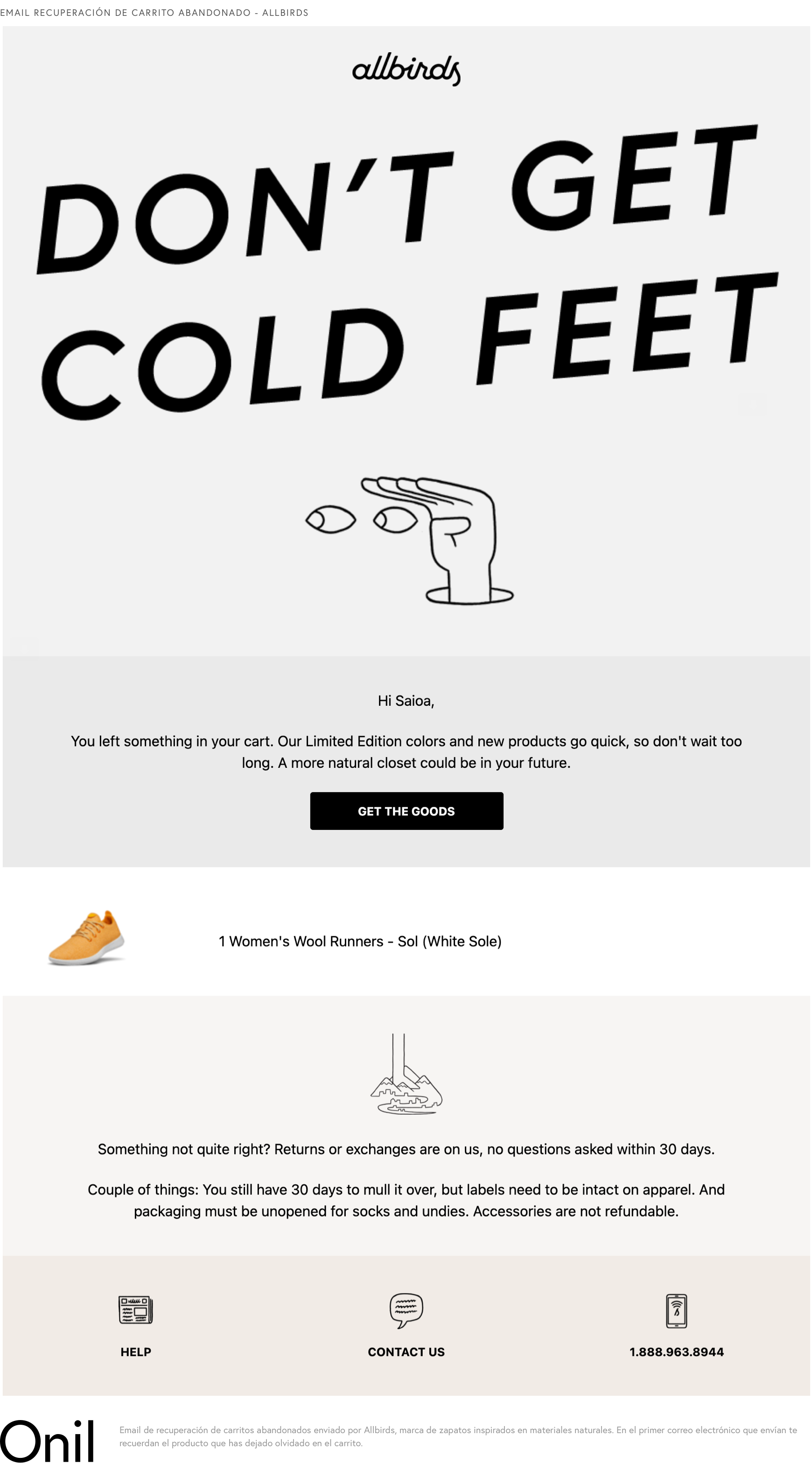
It is also useful to include recommendations for other products similar to the one you have added to the cart, in case you are more convinced than the other or the same product but in different sizes or colors in case the first choice is not the correct one.
All in order to make it easier for the customer to return to the store and finalize their purchase.
2. Include a call-to-action (CTA) button
As you well know, a call to action button or CTA is the one that guides the client towards the action that you want them to carry out.
In this case, a CTA button is the button that is used in the email to guide the customer to the cart where the product has been left behind.
To make it clearer, it's the part of the email that the customer has to click on to perform the action you want them to do.
These types of buttons can have different styles, everything will depend on your brand, but they will all have the same objective:
“Make users return to the store and complete the purchase”
To encourage abandoned cart email recipients, you can use a standard CTA such as “Buy Now” or “Back to Cart”.

Or, on the contrary, work a little harder and be more creative using CTAs like “Get my 10% discount”.
Which of the 2 types of CTAs would encourage you the most to return to the cart and complete the purchase?
Surely the one that offers a discount, right?
The best of all is to try different CTAs and see which ones give you the best results.
3. Offer a discount
As I have already told you, many customers abandon their shopping carts due to unexpected additional costs that they discover when they go to checkout.
And a very simple way to win back those customers who have left due to unexpected extra costs is to offer them a discount on the cart recovery email you send them.
This is the case of Partake Foods, where in the second cart recovery email they send, they offer you a 20% discount with the aim of encouraging the customer to finish the purchase they had started.
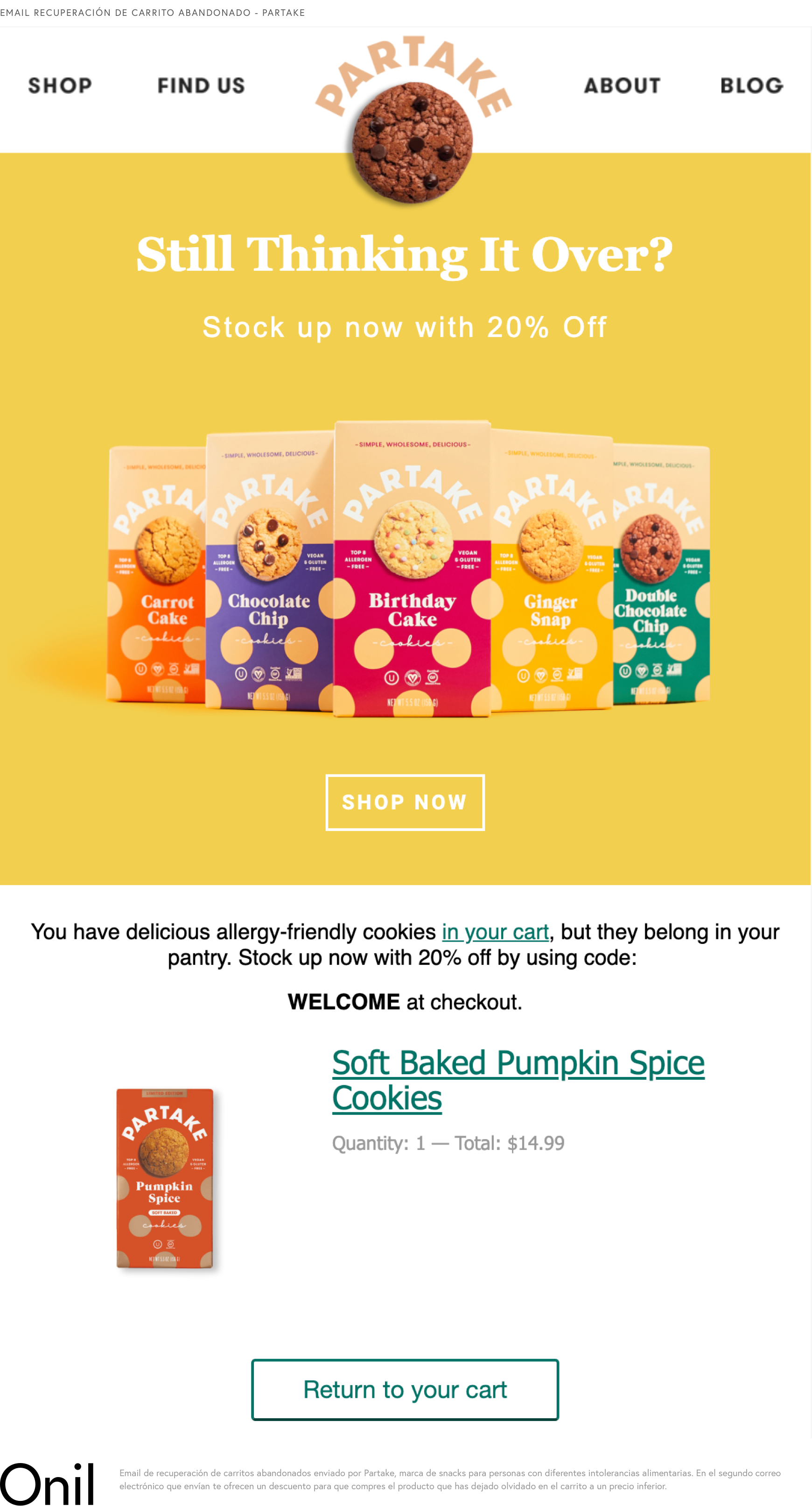
According to data from Klaviyo , abandoned cart emails that include a discount coupon have an above-average open (44.37%) and click-through (10.85%) rate.
4. Know how to choose the right moment
Oddly enough, timing your abandoned cart emails is vital to getting customers to come back and buy.
If you wait a long time to send the first email, the customer's motivation to add the product to the cart may have already worn off.
And if you send the email too quickly, the reason why they decided to abandon the product in the cart may still be very present.
So it is recommended to send 3 emails:
- The first email has to be sent one hour after the customer has abandoned their cart as a reminder email that they left something in the cart.
- The second email 12 hours after the customer has abandoned their cart, generating urgency.
- The third email 24 hours after abandoning the cart with an incentive to encourage them to complete the purchase.
5. Include what is known as social proof
The importance of opinions is undeniable when it comes to encouraging others to buy.
In addition, it is the best way to build trust among those who have abandoned their cart and encourage them to complete the purchase.
By including opinions and reviews from other shoppers in cart recovery emails, recipients can see what they are saying about your brand or recently purchased products, encouraging them to return to the store and complete the purchase.
How can you send these types of emails in Shopify?
If you have your online store on Shopify, don't worry as Shopify has an abandoned cart recovery feature built into its own platform.
This feature that Shopify offers out of the box is very basic and limited, so in order to recover those lost sales in a more effective way, it is recommended to use Shopify applications or third-party integrations.
We usually recommend Klaviyo to the clients we work with because it is a tool more focused on ecommerce, it is also the best option for segmenting, creating email flows about abandoned carts, post-purchase, customer recovery... In short, is a tool for email and SMS marketing.
There are also other applications that you can use to carry out abandoned cart email flows such as Mailchimp or Active Campaign .
Conclusion
If you have an online store, surely you have already experienced abandoned carts firsthand, but with these 6 techniques that you can start applying now in your e-commerce, you can considerably reduce this problem and increase your sales.
